Ocean Rocks
Ken Neill
Published in Chesapeake Angler
 There was a time when our local marinas and tackle stores looked mostly abandoned during the winter. The recovery of one fish changed that in dramatic fashion. Now, the marinas near the oceanfront are full with more boats clamoring for slips and tackle shops are bustling all winter long. Each year, the majority of the Atlantic striped bass stock spends the wintertime in our coastal waters. Anglers, from all over the country, flock to our coast to get in on what can be some of the best fishing action of the year.
There was a time when our local marinas and tackle stores looked mostly abandoned during the winter. The recovery of one fish changed that in dramatic fashion. Now, the marinas near the oceanfront are full with more boats clamoring for slips and tackle shops are bustling all winter long. Each year, the majority of the Atlantic striped bass stock spends the wintertime in our coastal waters. Anglers, from all over the country, flock to our coast to get in on what can be some of the best fishing action of the year.
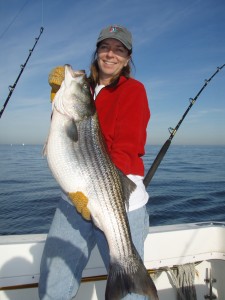 When it is good, fishing can be ridiculously easy. Birds will be diving out of the sky showing you right where the fish are feeding. These aggressively feeding fish attack anything placed in front of them and you have caught your limit of big rockfish in 15 minutes of fishing. It really is just that easy…except when it is not.
When it is good, fishing can be ridiculously easy. Birds will be diving out of the sky showing you right where the fish are feeding. These aggressively feeding fish attack anything placed in front of them and you have caught your limit of big rockfish in 15 minutes of fishing. It really is just that easy…except when it is not.
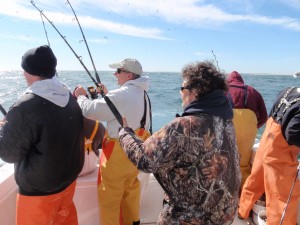 When the ocean seems like it is boiling with life, anybody can catch fish and you can catch them anyway you want. Vertical jigging with light tackle is popular when it is good. Casting lures, especially top-water plugs, to feeding rockfish is a blast. This is a time to break out the fly rod. When you get out there and the ocean resembles a dessert, all you will be doing with these techniques is getting some exercise.
When the ocean seems like it is boiling with life, anybody can catch fish and you can catch them anyway you want. Vertical jigging with light tackle is popular when it is good. Casting lures, especially top-water plugs, to feeding rockfish is a blast. This is a time to break out the fly rod. When you get out there and the ocean resembles a dessert, all you will be doing with these techniques is getting some exercise.
It is a big ocean out there to find fish in. There are some things we can do to make the search more productive. Currently, the government has greatly decreased our search area as waters outside the 3 nautical-mile demarcation line are closed to striped bass fishing. We now can limit our search in that narrow band of water from the beach out 3 miles. We still have a lot of miles up and down the coast to find our rockfish.
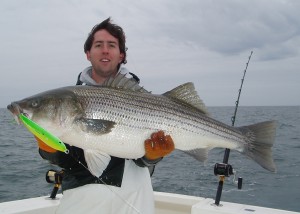 Consider the water temperature when starting your search. Colder water may mean that you should think south. Earlier in the winter season, when water temperatures are still in the upper forties, a run north, up the coast may be called for. Satellite temperature services can be of help in seeing where water temperature changes are.
Consider the water temperature when starting your search. Colder water may mean that you should think south. Earlier in the winter season, when water temperatures are still in the upper forties, a run north, up the coast may be called for. Satellite temperature services can be of help in seeing where water temperature changes are.
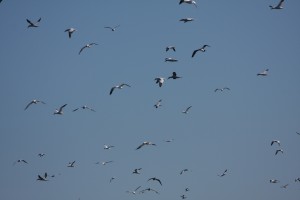 Use your Radar if you have it. Working birds will look like a faint rain signature on your screen. When you are marking rain when it is not raining, it is probably worth running and checking it out.
Use your Radar if you have it. Working birds will look like a faint rain signature on your screen. When you are marking rain when it is not raining, it is probably worth running and checking it out.
Look at the contour lines on your charts. 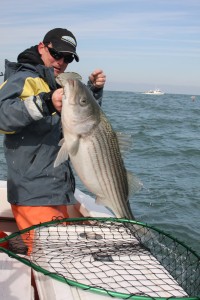 Striped bass will blitz right up on the beach. There is no water too shallow for them to feed in but when they are hunkered down somewhere with no signs of life, look for where deeper water comes inside the 3 nautical-mile line. Some trawl studies have shown that the 60-foot contour line is a favorite “hang-out” area for wintering striped bass.
Striped bass will blitz right up on the beach. There is no water too shallow for them to feed in but when they are hunkered down somewhere with no signs of life, look for where deeper water comes inside the 3 nautical-mile line. Some trawl studies have shown that the 60-foot contour line is a favorite “hang-out” area for wintering striped bass.
Look for bait on your bottom machine. If you find good bait marks, you have found a good area to fish even without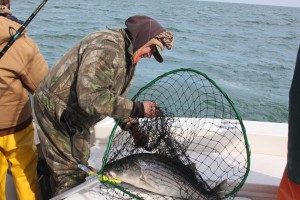 other signs of fish. Striped bass just do not feed all of the time. When they do decide that it is time to eat, they will know where their food is and will be coming to eat. You will be there waiting for them.
other signs of fish. Striped bass just do not feed all of the time. When they do decide that it is time to eat, they will know where their food is and will be coming to eat. You will be there waiting for them.
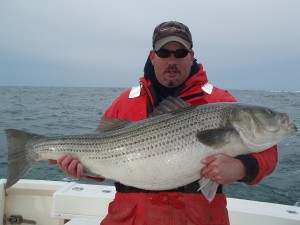 We have some great days when we could not seem to find anything at all. No signs of a bait or birds and we have run as far and have burned as much fuel as we are willing to do. Not knowing what else to try, we put out our baits and start trolling. We are just covering ground and then the fish appear on the bottom machine. Next, all the rods go down. They are hard to stay on when you just find them by themselves with no bait or birds to help show you where they are. Just keep working the area and mark a waypoint each time you find them and you will see how they are moving and you will be able to stay on them better.
We have some great days when we could not seem to find anything at all. No signs of a bait or birds and we have run as far and have burned as much fuel as we are willing to do. Not knowing what else to try, we put out our baits and start trolling. We are just covering ground and then the fish appear on the bottom machine. Next, all the rods go down. They are hard to stay on when you just find them by themselves with no bait or birds to help show you where they are. Just keep working the area and mark a waypoint each time you find them and you will see how they are moving and you will be able to stay on them better.
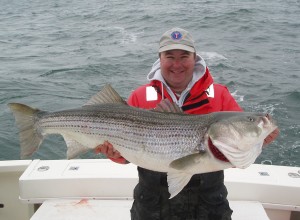 You have to be a bit lucky and persistent to find them in the blind like that but when you do, the catching can be great and you will have them all to yourself. Still, I like it best when the birds are falling out of the sky and big fish are rolling all over the surface. Easy is good and fortunately, our wintertime rockfish fishery is often very easy.
You have to be a bit lucky and persistent to find them in the blind like that but when you do, the catching can be great and you will have them all to yourself. Still, I like it best when the birds are falling out of the sky and big fish are rolling all over the surface. Easy is good and fortunately, our wintertime rockfish fishery is often very easy.
